ITIL_V3_持续性服务改进
ITIL v2 vs v3

我们接着向各位介绍ITIL相关的知识,这次的内容主要是ITIL V2与V3比较。
ITIL自从发布以来,就一直在不断的发展和完善,期间有三次重要的版本发布,分别是ITIL V1、ITIL V2和ITIL V3。
ITIL V2于1999年正式发布,当ITIL 概念被引入中国的时候,V2已经行业内大行其道,因此对ITIL概念接触比较早的同事可能都对V2比较熟悉,ITIL V3则于2007年正式发布,其模型如如下:严格说起来,V3只是V2的加强版,补足与解释V2的不足之处,并不是对V2的颠覆,ITIL V2所有的流程(Processes)和职能(function)在V3中同样存在,也没有太大的变化。
V3的最大改变就是引入了服务的生命周期概念,并将所有的流程围绕着服务的生命周期进行了模块划分,大大增强了各模块之间的逻辑关系。
V2与V3的模块与流程对比如下表格所示:上述表格中红色字体标准的流程是V3新增的流程和职能,共8个流程和3各职能,其中Event Management Process和Request Fulfillment Management Process是中V2中的Incident Management process中拆分出来的,在V2中这两个流程涵盖的事情都是通过Incident management来处理。
V2是10+1(10个流程加1个职能),V3则是18+4(18个流程+4个职能)。
在特征在V3相比V2有以下5个方面的区别:从宏观上看,ITIL V3的主要亮点有:1.V3引入了生命周期的概念,它通过PDCA模型,可以不断地循环改进,从而保持ITIL的生命活力。
V2的核心只有服务支持和服务交付,模块之间逻辑关系不是很强,V3则通过服务策略、服务介绍、服务实施、服务提升等先后顺序来实施,IT 服务管理的实施过程被有机整合为一个良性循环的整体。
2.V3提供了丰富的管理方法和概念。
V3引入了很多行业的管理实施方案,借助这些丰富的资源,用户可以很方便地在企业中实施IT服务管理,也提出并借鉴了很多管理学概念(例如项目管理、质量管理、运作管理、CMI等)。
ITILV3认证体系

最新ITIL V3认证体系ITIL V3自2007年5月发布以来,已经逐步被业界认可并接受,想了解和学习ITIL V3的单位和个人也越来越多。
为此,我们觉得有必要把ITIL V3的认证(课程)体系给大家介绍一下。
图一:ITIL V3认证体系如图一所示,ITIL V3的认证由四个级别构成。
它们分别是最下面红色背景的基础认证(Foundation),中间绿色、灰色和粉红色背景的中级认证(Intermediate),上面黑色背景的专家认证(ITIL Expert)和最上面蓝色背景的大师认证(ITIL Master)。
但是,大师级别的认证目前还在开发中,还不可用。
ITIL V3的认证采用学分制,要拿到ITIL Expert的认证,需要22个学分。
■ITIL V3的基础认证对应一门课程和一门考试,课程和考试信息如下:1、课程名称:ITIL V3初级课程_基础(ITIL V3 Foundation)课程长度:脱产班3天(18小时,含考试),周末班2天(15小时,不含考试)考试名称:ITIL V3 Foundation考试时间:1小时(60分钟)考题数量:40道单项选择题,答对26道题(65%)通过■ITIL V3的中级认证比较复杂,它分为两个层次,一共10门课程(考试)。
由两个模块组成,一个是能力模块(Capability Modules),有四门课程(考试);一个是生命周期模块(Lifecycle Modules),有五门课程(考试)。
第二个层次(也可以认为是高级课程)是一门跨生命周期的课程(考试),内容覆盖ITIL V3的五本核心书籍。
ITIL V3中级(第一层次)能力模块的四门课程(考试)信息如下:1、课程名称:ITILV3中级课程_能力模块_运营支持与分析(OSA)课程长度:脱产班5天(30小时,含考试),周末班4天(30小时,含考试)考试名称:ITIL® V3 Intermediate Capability Stream: OPERATIONAL SUPPORT AND ANALYSIS (OS&A)考试时间:90分钟(针对英语为母语的人群),120分钟(针对英语为非母语的人群)考题数量:8道单项选择题(场景题),每题满分5分(4个答案对应的得分为5、3、1、0),整个卷面的满分为40分,28分(70%)通过。
ITILV3优势
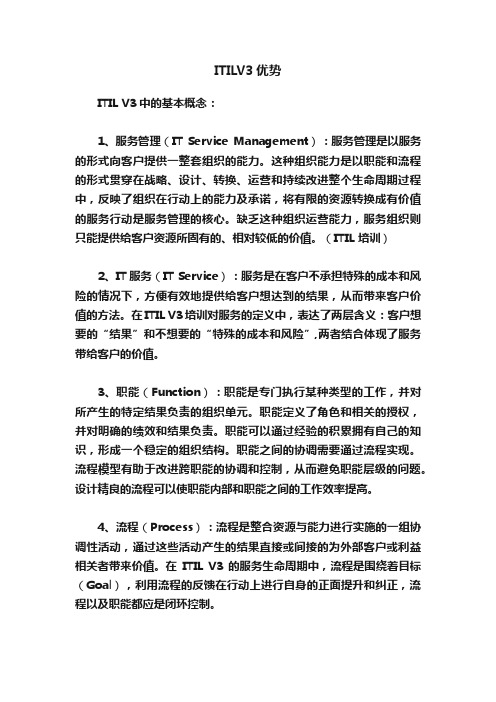
ITILV3优势ITIL V3中的基本概念:1、服务管理(IT Service Management):服务管理是以服务的形式向客户提供一整套组织的能力。
这种组织能力是以职能和流程的形式贯穿在战略、设计、转换、运营和持续改进整个生命周期过程中,反映了组织在行动上的能力及承诺,将有限的资源转换成有价值的服务行动是服务管理的核心。
缺乏这种组织运营能力,服务组织则只能提供给客户资源所固有的、相对较低的价值。
(ITIL 培训)2、IT服务(IT Service):服务是在客户不承担特殊的成本和风险的情况下,方便有效地提供给客户想达到的结果,从而带来客户价值的方法。
在ITIL V3培训对服务的定义中,表达了两层含义:客户想要的“结果”和不想要的“特殊的成本和风险”,两者结合体现了服务带给客户的价值。
3、职能(Function):职能是专门执行某种类型的工作,并对所产生的特定结果负责的组织单元。
职能定义了角色和相关的授权,并对明确的绩效和结果负责。
职能可以通过经验的积累拥有自己的知识,形成一个稳定的组织结构。
职能之间的协调需要通过流程实现。
流程模型有助于改进跨职能的协调和控制,从而避免职能层级的问题。
设计精良的流程可以使职能内部和职能之间的工作效率提高。
4、流程(Process):流程是整合资源与能力进行实施的一组协调性活动,通过这些活动产生的结果直接或间接的为外部客户或利益相关者带来价值。
在ITIL V3 的服务生命周期中,流程是围绕着目标(Goal),利用流程的反馈在行动上进行自身的正面提升和纠正,流程以及职能都应是闭环控制。
服务战略(Service Strategy):服务是无形的。
任何服务供应商都必须有一个基本的认识,即他们的客户不是购买商品,而是购买特定需求的满意度。
因此,服务供应方如果想要取得成功,就要被客户所认可,那么也就要交付给客户足够的价值,这种价值最好是以成果的形式体现,这才是客户想要得到的。
2024年度ITILV3学习

03
设计职业发展路径
根据员工能力模型和职业发展需求,设计清晰的职业发展路径,为员工
提供广阔的职业发展空间和机会。同时,建立相应的激励机制,鼓励员
工不断提升自身能力,实现个人价值。
29
06 ITILV3实施效果 评估方法
2024/2/2
30
制定明确评估目标和指标体系
确定评估目标
明确ITILV3实施效果评估的具体 目的,如提升服务质量、降低成
确保服务设计满足业务需求和 质量标准
2024/2/2
10
服务转换模块
规划和管理服务变更和发布 评估服务转换的风险和影响
确保服务转换的顺利进行 制定应急计划和恢复策略
2024/2/2
11
服务运营模块
01
管理和监控服 务运营过程Leabharlann 02确保服务质量 和性能的稳定
2024/2/2
处理服务请求 和事件
03
04
2024/2/2
数据分析
运用统计和分析方法,对数据进行深入挖掘和分析,发现数据背 后的规律和趋势。
33
撰写评估报告并提出改进建议
撰写评估报告
根据评估结果,撰写详细的评估报告,包括评估过程、结果分析、 存在问题等。
提出改进建议
针对评估中发现的问题和不足,提出具体的改进建议,包括优化流 程、提升服务质量等。
变更回顾与改进
对变更过程进行回顾和总结,持续改进变更 管理流程。
17
发布管理流程与实践应用
发布计划与审批
制定详细的发布计划,并进行审批。
发布实施与监控
按照发布计划实施发布,并进行实时监控 。
发布验证与回滚
发布总结与改进
对发布结果进行验证,如有问题及时回滚 。
ITIL V3 中级-生命周期模块5-持续服务改进课程大纲
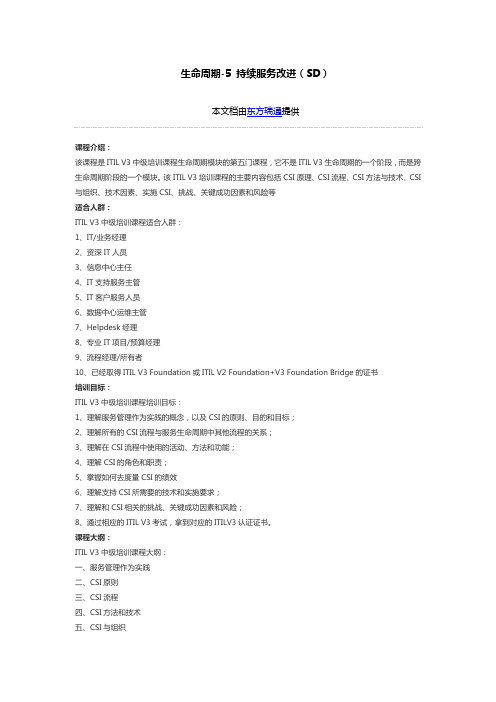
生命周期-5 持续服务改进(SD)
本文档由东方瑞通提供
课程介绍:
该课程是ITIL V3中级培训课程生命周期模块的第五门课程,它不是ITIL V3生命周期的一个阶段,而是跨生命周期阶段的一个模块。
该ITIL V3培训课程的主要内容包括CSI原理、CSI流程、CSI方法与技术、CSI 与组织、技术因素、实施CSI、挑战、关键成功因素和风险等
适合人群:
ITIL V3中级培训课程适合人群:
1、IT/业务经理
2、资深IT人员
3、信息中心主任
4、IT支持服务主管
5、IT客户服务人员
6、数据中心运维主管
7、Helpdesk经理
8、专业IT项目/预算经理
9、流程经理/所有者
10、已经取得ITIL V3 Foundation或ITIL V2 Foundation+V3 Foundation Bridge的证书
培训目标:
ITIL V3中级培训课程培训目标:
1、理解服务管理作为实践的概念,以及CSI的原则、目的和目标;
2、理解所有的CSI流程与服务生命周期中其他流程的关系;
3、理解在CSI流程中使用的活动、方法和功能;
4、理解CSI的角色和职责;
5、掌握如何去度量CSI的绩效
6、理解支持CSI所需要的技术和实施要求;
7、理解和CSI相关的挑战、关键成功因素和风险;
8、通过相应的ITIL V3考试,拿到对应的ITILV3认证证书。
课程大纲:
ITIL V3中级培训课程大纲:
一、服务管理作为实践
二、CSI原则
三、CSI流程
四、CSI方法和技术
五、CSI与组织
六、技术考虑
七、实施CSI。
ITIL_V3题库大全
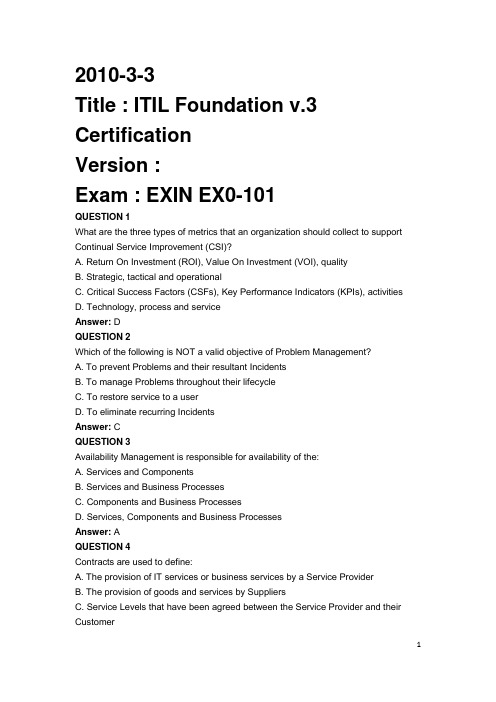
2010-3-3Title : ITIL Foundation v.3 CertificationVersion :Exam : EXIN EX0-101QUESTION 1What are the three types of metrics that an organization should collect to support Continual Service Improvement (CSI)?A. Return On Investment (ROI), Value On Investment (VOI), qualityB. Strategic, tactical and operationalC. Critical Success Factors (CSFs), Key Performance Indicators (KPIs), activitiesD. Technology, process and serviceAnswer: DQUESTION 2Which of the following is NOT a valid objective of Problem Management?A. To prevent Problems and their resultant IncidentsB. To manage Problems throughout their lifecycleC. To restore service to a userD. To eliminate recurring IncidentsAnswer: CQUESTION 3Availability Management is responsible for availability of the:A. Services and ComponentsB. Services and Business ProcessesC. Components and Business ProcessesD. Services, Components and Business ProcessesAnswer: AQUESTION 4Contracts are used to define:A. The provision of IT services or business services by a Service ProviderB. The provision of goods and services by SuppliersC. Service Levels that have been agreed between the Service Provider and their CustomerD. Metrics and Critical Success Factors (CSFs) in an external agreement Answer: BQUESTION 5Which of the following is NOT an example of Self-Help capabilities?A. Requirement to always call the Service Desk for service requestsB. Web front-endC. Menu-driven range of self help and service requestsD. A direct interface into the back-end process-handling softwareAnswer: AQUESTION 6Who owns the specific costs and risks associated with providing a service?A. The Service ProviderB. The Service Level ManagerC. The CustomerD. The Finance departmentAnswer: AQUESTION 7Which of the following are types of communication you could expect the functions within Service Operation to perform?1. Communication between Data Centre shifts2. Communication related to changes3. Performance reporting4. Routine operational communicationA. 1 onlyB. 2 and 3 onlyC. 1, 2 and 4 onlyD. All of the aboveAnswer: DQUESTION 8How many people should be accountable for a process as defined in the RACI model?A. As many as necessary to complete the activityB. Only one - the process ownerC. Two - the process owner and the process enactorD. Only one - the process architectAnswer: BQUESTION 9What guidance does ITIL give on the frequency of production of service reporting?A. Service reporting intervals must be defined and agreed with the customersB. Reporting intervals should be set by the Service ProviderC. Reports should be produced weeklyD. Service reporting intervals must be the same for all servicesAnswer: AQUESTION 10Which of the following is the BEST definition of the term Service Management?A. A set of specialised organizational capabilities for providing value to customers in the form of servicesB. A group of interacting, interrelated, or independent components that form a unified whole, operating together for a common purposeC. The management of functions within an organization to perform certain activitiesD. Units of organizations with roles to perform certain activitiesAnswer: AQUESTION 11Which of the following is NOT a characteristic of a process?A. It is measurableB. Delivers specific resultsC. Responds to specific eventsD. A method of structuring an organizationAnswer: DQUESTION 12Which of the following would be defined as part of every process?1. Roles2. Activities3. Functions4. ResponsibilitiesA. 1 and 3 onlyB. All of the aboveC. 2 and 4 onlyD. 1, 2 and 4 onlyAnswer: DQUESTION 13Which of the following statements is CORRECT for every process?1. It delivers its primary results to a customer or stakeholder2. It defines activities that are executed by a single functionA. Both of the aboveB. 1 onlyC. Neither of the aboveD. 2 onlyAnswer: BQUESTION 14What are the publications that provide guidance specific to industry sectors and organization typesknown as?A. The Service Strategy and Service Transition booksB. The ITIL Complementary GuidanceC. The Service Support and Service Delivery booksD. Pocket GuidesAnswer: BQUESTION 15Which of the following is NOT a purpose of Service Transition?A. To ensure that a service can be managed, operated and supportedB. To provide training and certification in project managementC. To provide quality knowledge of Change, Release and Deployment ManagementD. To plan and manage the capacity and resource requirements to manage a release Answer: BQUESTION 16What is the BEST description of the purpose of Service Operation?A. To decide how IT will engage with suppliers during the Service Management LifecycleB. To proactively prevent all outages to IT ServicesC. To design and build processes that will meet business needsD. To deliver and manage IT Services at agreed levels to business users and customersAnswer: DQUESTION 17Which of the following should NOT be a concern of Risk Management?A. To ensure that the organization can continue to operate in the event of a major disruption or disasterB. To ensure that the workplace is a safe environment for its employees and customersC. To ensure that the organization assets, such as information, facilities and building are protected fromthreats, damage or lossD. To ensure only the change requests with mitigated risks are approved forimplementationAnswer: DQUESTION 18What is the BEST description of an Operational Level Agreement (OLA)?A. An agreement between the service provider and another part of the same organizationB. An agreement between the service provider and an external organizationC. A document that describes to a customer how services will be operated on a day-to-day basisD. A document that describes business services to operational staffAnswer: AQUESTION 19Which of the following is the CORRECT definition of a Release Unit?A. A measurement of costB. A function described within Service TransitionC. The team of people responsible for implementing a releaseD. The portion of a service or IT infrastructure that is normally released together Answer: DQUESTION 20The BEST definition of an Incident is:A. An unplanned disruption of service unless there is a backup to that serviceB. An unplanned interruption or reduction in the quality of an IT ServiceC. Any disruption to service whether planned or unplannedD. Any disruption to service that is reported to the Service Desk, regardless of whether the service is impacted or notAnswer: BQUESTION 21In which of the following situations should a Problem Record be created?A. An event indicates that a redundant network segment has failed but it has not impacted any usersB. An Incident is passed to second-level supportC. A Technical Management team identifies a permanent resolution to a number of recurring IncidentsD. Incident Management has found a workaround but needs some assistance in implementing itAnswer: CQUESTION 22Which of the following BEST describes a Problem?A. A Known Error for which the cause and resolution are not yet knownB. The cause of two or more IncidentsC. A serious Incident which has a critical impact to the businessD. The cause of one or more IncidentsAnswer: DQUESTION 23Implementation of ITIL Service Management requires preparing and planning the effective and efficientuse of:A. People, Process, Partners, SuppliersB. People, Process, Products, TechnologyC. People, Process, Products, PartnersD. People, Products, Technology, PartnersAnswer: CQUESTION 24What would be the next step in the Continual Service Improvement (CSI) Model after:1. What is the vision?2. Where are we now?3. Where do we want to be?4. How do we get there?5. Did we get there?6. ?A. What is the Return On Investment (ROI)?B. How much did it cost?C. How do we keep the momentum going?D. What is the Value On Investment (VOI)?Answer: CQUESTION 25Which of the following do Service Metrics measure?A. Processes and functionsB. Maturity and costC. The end to end serviceD. Infrastructure availabilityAnswer: CQUESTION 26The MAIN objective of Service Level Management is:A. To carry out the Service Operations activities needed to support current IT servicesB. To ensure that sufficient capacity is provided to deliver the agreed performance ofservicesC. To create and populate a Service CatalogueD. To ensure that an agreed level of IT service is provided for all current IT services Answer: DQUESTION 27Which processes review Underpinning Contracts on a regular basis?A. Supplier Management and Service Level ManagementB. Supplier Management and Demand ManagementC. Demand Management and Service Level ManagementD. Supplier Management, Demand Management and Service Level Management Answer: AQUESTION 28Which of the following statements about the Service Portfolio and Service Catalogue is the MOST CORRECT?A. The Service Catalogue only has information about services that are live, or being prepared for deployment; the Service Portfolio only has information about services which are being considered for future developmentB. The Service Catalogue has information about all services; the Service Portfolio only has information about services which are being considered for future developmentC. The Service Portfolio has information about all services; the Service Catalogue only has information about services which are live, or being prepared for deploymentD. Service Catalogue and Service Portfolio are different names for the same thing Answer: CQUESTION 29Which role or function is responsible for monitoring activities and events in the IT Infrastructure?A. Service Level ManagementB. IT Operations ManagementC. Capacity ManagementD. Incident ManagementAnswer: BQUESTION 30Consider the following list:1. Change Authority2. Change Manager3. Change Advisory Board (CAB)What are these BEST described as?A. Job descriptionsB. FunctionsC. TeamsD. Roles, people or groupsAnswer: DQUESTION 31Service Transition contains detailed descriptions of which processes?A. Change Management, Service Asset and Configuration Management, Release and Deployment ManagementB. Change Management, Capacity Management Event Management, Service Request ManagementC. Service Level Management, Service Portfolio Management, Service Asset and Configuration ManagementD. Service Asset and Configuration Management, Release and Deployment Management, Request FulfilmentAnswer: AQUESTION 32Which of the following statements is CORRECT?A. The Configuration Management System is part of the Known Error Data BaseB. The Service Knowledge Management System is part of the Configuration Management SystemC. The Configuration Management System is part of the Service Knowledge Management systemD. The Configuration Management System is part of the Configuration Management DatabaseAnswer: CQUESTION 33Major Incidents require:A. Separate proceduresB. Less urgencyC. Longer timescalesD. Less documentationAnswer: AQUESTION 34Which of the following statements about Incident reporting and logging is CORRECT?A. Incidents can only be reported by users, since they are the only people who know when a service has been disruptedB. Incidents can be reported by anyone who detects a disruption or potentialdisruption to normal service. This includes technical staffC. All calls to the Service Desk must be logged as Incidents to assist in reporting Service Desk activityD. Incidents reported by technical staff must be logged as Problems because technical staff manage infrastructure devices not servicesAnswer: BQUESTION 35What is the BEST description of a Major Incident?A. An Incident that is so complex that it requires root cause analysis before a workaround can be foundB. An Incident which requires a large number of people to resolveC. An Incident logged by a senior managerD. An Incident which has a high priority or high impact on the businessAnswer: DQUESTION 36Which of the following should be done when closing an incident?1. Check the incident categorization and correct it if necessary2. Check that user is satisfied with the outcomeA. 1 onlyB. Both of the aboveC. 2 onlyD. Neither of the aboveAnswer: BQUESTION 37Which of the following statements correctly states the relationship between urgency, priority and impact?A. Impact, priority and urgency are independent of each otherB. Urgency should be based on impact and priorityC. Impact should be based on urgency and priorityD. Priority should be based on impact and urgencyAnswer: DQUESTION 38Hierarchic escalation is best described as?A. Notifying more senior levels of management about an IncidentB. Passing an Incident to people with a greater level of technical skillC. Using more senior specialists than necessary to resolve an Incident to maintain customer satisfactionD. Failing to meet the Incident resolution times specified in a Service LevelAgreementAnswer: AQUESTION 39Which of the following BEST describes a Service Request?A. A request from a User for information, advice or for a Standard ChangeB. Anything that the customer wants and is prepared to pay forC. Any request or demand that is entered by a user via a Self-Help web-based interfaceD. Any Request for Change (RFC) that is low risk and can be approved by the Change Manager without a Change Advisory Board (CAB) meetingAnswer: AQUESTION 40Event Management, Problem Management, Access Management and Request Fulfilment are part of which stage of the Service Lifecycle?A. Service StrategyB. Service TransitionC. Service OperationD. Continual Service ImprovementAnswer: CQUESTION 41Which of the following is NOT a valid objective of Request Fulfilment?A. To provide information to users about what services are available and how to request themB. To update the Service Catalogue with services that may be requested through the Service DeskC. To provide a channel for users to request and receive standard servicesD. To source and deliver the components of standard services that have been requestedAnswer: BQUESTION 42Which process is responsible for sourcing and delivering components of requested standard services?A. Request FulfilmentB. Service Portfolio ManagementC. Service DeskD. IT FinanceAnswer: AQUESTION 43Which of the following are Service Desk organizational structures?1. Local Service Desk2. Virtual Service Desk3. IT Help Desk4. Follow the SunA. 1, 2 and 4 onlyB. 2, 3 and 4 onlyC. 1, 3 and 4 onlyD. 1, 2 and 3 onlyAnswer: AQUESTION 44Which Functions are included in IT Operations Management?A. Network Management and Application ManagementB. Technical Management and Change ManagementC. IT Operations Control and Facilities ManagementD. Facilities Management and Release ManagementAnswer: CQUESTION 45Which of the following options is a hierarchy that is used in Knowledge Management?A. Wisdom - Information - Data - KnowledgeB. Data - Information - Knowledge - WisdomC. Knowledge - Wisdom - Information - DataD. Information - Data - Knowledge - WisdomAnswer: BQUESTION 46Which of the following CANNOT be provided by a tool?A. KnowledgeB. InformationC. WisdomD. DataAnswer: CQUESTION 47The BEST processes to automate are those that are:A. Carried out by Service OperationsB. Carried out by lots of peopleC. Critical to the success of the business missionD. Simple and well understoodAnswer: DQUESTION 48Which of the following areas would technology help to support during the Service Transition phase of the lifecycle?1. Data mining and workflow tools2. Measurement and reporting systems3. Release and deployment technology4. Process DesignA. 2, 3 and 4 onlyB. 1, 3 and 4 onlyC. 1, 2 and 3 onlyD. All of the aboveAnswer: CQUESTION 49Which of the following are the two primary elements that create value for customers?A. Value on Investment (VOI), Return on Investment (ROI)B. Customer and User satisfactionC. Understanding Service Requirements and WarrantyD. Utility and WarrantyAnswer: DQUESTION 50Within Service Design, what is the key output handed over to Service Transition?A. Measurement, methods and metricsB. Service Design PackageC. Service Portfolio DesignD. Process definitionsAnswer: BQUESTION 51What is the Service Pipeline?A. All services that are at a conceptual or development stageB. All services except those that have been retiredC. All services that are contained within the Service Level Agreement (SLA)D. All complex multi-user servicesAnswer: AQUESTION 52Which of the following statements BEST describes a Definitive Media Library (DML)?A. A secure location where definitive hardware spares are heldB. A secure library where definitive authorised versions of all media Configuration Items (CIs) are stored and protectedC. A database that contains definitions of all media CIsD. A secure library where definitive authorised versions of all software and back-ups are stored and protectedAnswer: BQUESTION 53In the phrase "People, Processes, Products and Partners". Products refers to:A. IT Infrastructure and ApplicationsB. Services, technology and toolsC. Goods provided by third parties to support the IT ServicesD. All assets belonging to the Service ProviderAnswer: BQUESTION 54Defining the processes needed to operate a new service is part of:A. Service Design: Design the processesB. Service Strategy: Develop the offeringsC. Service Transition: Plan and prepare for deploymentD. Service Operation: IT Operations ManagementAnswer: AQUESTION 55Which Service Design process makes the most use of data supplied by Demand Management?A. Service Catalogue ManagementB. Service Level ManagementC. IT Service Continuity ManagementD. Capacity ManagementAnswer: DQUESTION 56Which of these are objectives of Service Level Management1: Defining, documenting and agreeing the level of IT Services to be provided2: Monitoring, measuring and reporting the actual level of services provided3: Monitoring and improving customer satisfaction4: Identifying possible future markets that the Service Provider could operate inA. 1, 2 and 3 onlyB. 1 and 2 onlyC. 1, 2 and 4 onlyD. All of the aboveAnswer: AQUESTION 57Which process is responsible for discussing reports with customers showing whether services have met their targets?A. Continual Service ImprovementB. Business Relationship ManagementC. Service Level ManagementD. Availability ManagementAnswer: CQUESTION 58Which of the following does the Availability Management process include?1. Ensuring services are able to meet availability targets2. Monitoring and reporting actual availability3. Improvement activities, to ensure that services continue to meet or exceed their availability goalsA. 1 onlyB. All of the aboveC. 1 and 2 onlyD. 1 and 3 onlyAnswer: BQUESTION 59Reliability is a measure of:A. The availability of a service or componentB. The level of risk that could impact a service or processC. How long a service or component can perform its function without failingD. A measure of how quickly a service or component can be restored to normal workingAnswer: CQUESTION 60Which process is responsible for managing relationships with vendors?A. Change ManagementB. Service Portfolio ManagementC. Supplier ManagementD. Continual Service ImprovementAnswer: CQUESTION 61The Supplier Management process includes:1: Service Design activities, to ensure that contracts will be able to support the service requirements2: Service Operation activities, to monitor and report supplier achievements3: Continual Improvement activities, to ensure that suppliers continue to meet or exceed the needs of the businessA. 1 and 2 onlyB. 1 onlyC. All of the aboveD. 1 and 3 onlyAnswer: CQUESTION 62Data used to support the capacity management process should be stored in:A. A configuration management database (CMDB)B. A capacity database (CDB)C. A configuration management system (CMS)D. A capacity management information system (CMIS)Answer: DQUESTION 63Which process contains the Business, Service and Component sub-processes?A. Capacity ManagementB. Incident ManagementC. Service Level ManagementD. Financial ManagementAnswer: AQUESTION 64IT Service Continuity strategy should be based on:1: Design of the service technology2: Business continuity strategy3: Business Impact Analysis4: Risk assessmentA. 1, 2 and 4 onlyB. 1, 2 and 3 onlyC. 2, 3 and 4 onlyD. 1, 3 and 4 onlyAnswer: CQUESTION 65A change process model should include:1 - The steps that should be taken to handle the change with any dependences or co-processing defined, including handling issues and unexpected events2 - Responsibilities; who should do what, including escalation3 - Timescales and thresholds for completion of the actions4 - Complaints proceduresA. 1,2 and 3 onlyB. All of the aboveC. 1 and 2 onlyD. 1,2 and 4 onlyAnswer: AQUESTION 66Which of the following BEST describes a Change Authority?A. The Change Advisory BoardB. A person that provides formal authorisation for a particular type of change.C. A role, person or a group of people that provides formal authorisation for a particular type of change.D. The Change Manager who provides formal authorisation for each change Answer: CQUESTION 67Which of these would fall outside the scope of a typical service change management processA. A change to a contract with a supplierB. A firmware upgrade to a server that is only used for IT Service Continuity purposesC. An urgent need to replace a CPU to restore a service during an incidentD. A change to a business process that depends on IT ServicesAnswer: DQUESTION 68Which of the following statements BEST describes the aims of Release and Deployment Management?A. To build, test and deliver the capability to provide the services specified by Service Design and that will accomplish the stakeholders requirements and deliver the intended objectivesB. To ensure that each Release package specified by Service Design consists of a set of related assets and service components that are compatible with each otherC. To ensure that all Release and Deployment packages can be tracked, installed, tested, verified and/or uninstalled or backed out if appropriateD. To record and manage deviations, risks and issues related to the new or changed serviceAnswer: AQUESTION 69Which of the following BEST describes Technical Management?A. A Function responsible for Facilities Management and building control systemsB. A Function that provides hardware repair services for technology involved in the delivery of service to customersC. Senior managers responsible for all staff within the technical support FunctionD. A Function that includes the groups, departments or teams that provide technical expertise and overall management of the IT InfrastructureAnswer: DQUESTION 70Which of the following functions would be responsible for management of a data centre?A. Technical ManagementB. Service DeskC. IT Operations ControlD. Facilities ManagementAnswer: DQUESTION 71Which of these statements about Resources and Capabilities is CORRECT?A. Resources are types of Service Asset and Capabilities are notB. Resources and Capabilities are both types of Service AssetC. Capabilities are types of Service Asset and Resources are notD. Neither Capabilities nor Resources are types of Service AssetAnswer: BQUESTION 72A risk is:A. Something that won't happenB. Something that will happenC. Something that has happenedD. Something that might happenAnswer: DQUESTION 73A Service Level Agreement (SLA) is:A. The part of a contract that specifies responsibilities of each partyB. An agreement between the Service Provider and an internal organizationC. An agreement between a Service Provider and an external supplierD. An agreement between the Service Provider and their customerAnswer: DQUESTION 74The information that is passed to Service Transition to enable them to implement a new service is called:A. A Service Level PackageB. A Service Transition PackageC. A Service Design PackageD. A New Service PackageAnswer: CQUESTION 75When should tests for a new service be designed?A. At the same time as the service is designedB. After the service has been designed, before the service is handed over to Service TransitionC. As part of Service TransitionD. Before the service is designedAnswer: AQUESTION 76Which of these is the correct set of steps for the Continual Service Improvement Model?A. Devise a strategy; Design the solution; Transition into production; Operate the solution; Continually ImproveB. Where do we want to be? How do we get there?; How do we check we arrived? How do we keep the momentum going?C. Identify the required business outcomes; Plan how to achieve the outcomes; Implement the plan; Check the plan has been properly implemented; Improve the solutionD. What is the vision?; Where are we now?; Where do we want to be?; How do we get there?; Did we get there?; How do we keep the momentum going?Answer: DQUESTION 77Which of the following activities are helped by recording relationships between Configuration Items (CIs)?1. Assessing the impact and cause of Incidents and Problems2. Assessing the impact of proposed Changes3. Planning and designing a Change to an existing service4. Planning a technology refresh or software upgradeA. 1 and 2 onlyB. All of the aboveC. 1, 2 and 4 onlyD. 1, 3 and 4 onlyAnswer: BQUESTION 78A single Release unit, or a structured set of Release units can be defined within:A. The RACI ModelB. A Release PackageC. A Request ModelD. The Plan, Do, Check, Act (PDCA) cycleAnswer: BQUESTION 79What are Request Models used for?A. Capacity ManagementB. Modelling arrival rates and performance characteristics of service requestsC. Comparing the advantages and disadvantages of different Service Desk approaches such as local or remoteD. Identifying frequently received user requests and defining how they should be handledAnswer: DQUESTION 80What is the objective of Access Management?A. To provide security staff for Data Centers and other buildingsB. To manage access to computer rooms and other secure locationsC. To manage access to the Service DeskD. To manage the right to use a service or group of servicesAnswer: DQUESTION 81Identity and Rights are two major concepts involved in which one of the following processes?A. Access ManagementB. Facilities ManagementC. Event ManagementD. Demand ManagementAnswer: AQUESTION 82Which of these is the BEST description of a release unit?A. The portion of a service or IT infrastructure that is normally released togetherB. The smallest part of a service or IT infrastructure that can be independently changedC. The portion of a service or IT infrastructure that is changed by a particular releaseD. A metric for measuring the effectiveness of the Release and Deployment。
ITILV3培训教程

ITILV3培训教程ITIL(Information Technology Infrastructure Library)是一种IT服务管理框架。
该框架提供了IT服务管理的最佳实践,旨在帮助组织改进其IT服务管理的质量和效率。
ITILV3是ITIL框架的第三个版本。
ITILV3培训教程提供了学习和实施ITIL框架的资源,本文将介绍ITILV3培训教程的内容和重要性。
ITILV3培训教程的内容ITILV3培训教程旨在为IT专业人士提供全面的IT服务管理知识,包括以下方面:1. ITIL基础知识:ITIL基础知识包括ITIL框架的概述、ITIL的目标和价值、ITIL的体系结构等,以及IT服务管理的过程、角色和责任等。
2. IT服务战略管理:IT服务战略管理包括从业务角度定义IT服务组合和清晰的IT服务战略,以满足组织的需求。
3. IT服务设计管理:IT服务设计管理包括制定IT服务需求、设计IT服务解决方案、定制IT服务流程、定义IT服务水平协议等。
4. IT服务转换管理:IT服务转换管理包括IT服务的转换、更新和测试,确保IT服务顺利迁移。
5. IT服务运营管理:IT服务运营管理包括监视和控制IT服务,确保IT服务在符合业务需求的基础上交付高质量的服务。
6. IT服务持续改进管理:IT服务持续改进管理包括从业务和IT性能的角度进行评估,为IT服务提供贡献,以提高IT服务的质量和效率。
ITILV3培训教程的重要性ITILV3培训教程对于IT专业人士非常重要,因为它提供了IT服务管理的最佳实践,帮助他们更好地了解并实施ITIL框架。
以下是ITILV3培训教程的重要性:1. 帮助组织优化IT服务管理:ITILV3培训教程提供了IT服务管理的最佳实践,可以帮助组织优化IT服务管理,提高IT 服务的质量和效率,更好地满足组织的需求。
2. 提供IT服务管理知识和技能:ITILV3培训教程提供了IT 服务管理的知识和技能,使IT专业人士能够更好地了解和实施ITIL框架,帮助他们成为更好的IT服务管理专家。
ITIL-v3-简介
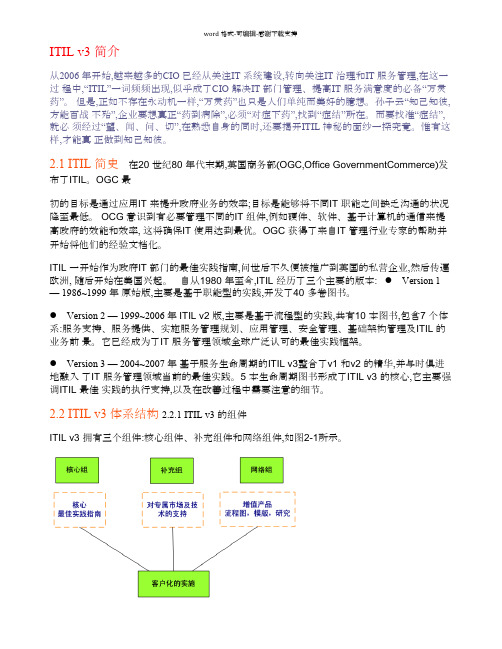
ITIL v3 简介从2006 年开始,越来越多的CIO 已经从关注IT 系统建设,转向关注IT 治理和IT 服务管理,在这一过程中,“ITIL”一词频频出现,似乎成了CIO 解决IT 部门管理、提高IT 服务满意度的必备“万灵药”。
但是,正如不存在永动机一样,“万灵药”也只是人们单纯而美好的臆想。
孙子云“知己知彼,方能百战不殆”,企业要想真正“药到病除”,必须“对症下药”,找到“症结”所在。
而要找准“症结”,就必须经过“望、闻、问、切”,在熟悉自身的同时,还要揭开ITIL 神秘的面纱一探究竟。
惟有这样,才能真正做到知己知彼。
2.1 ITIL 简史 在20 世纪80 年代末期,英国商务部(OGC,Office GovernmentCommerce)发布了ITIL。
OGC 最初的目标是通过应用IT 来提升政府业务的效率;目标是能够将不同IT 职能之间缺乏沟通的状况降至最低。
OCG 意识到有必要管理不同的IT 组件,例如硬件、软件、基于计算机的通信来提高政府的效能和效率, 这将确保IT 使用达到最优。
OGC 获得了来自IT 管理行业专家的帮助并开始将他们的经验文档化。
ITIL 一开始作为政府IT 部门的最佳实践指南,问世后不久便被推广到英国的私营企业,然后传遍欧洲, 随后开始在美国兴起。
自从1980 年至今,ITIL 经历了三个主要的版本: ● Version 1 — 1986~1999 年原始版,主要是基于职能型的实践,开发了40 多卷图书。
● Version 2 — 1999~2006 年ITIL v2 版,主要是基于流程型的实践,共有10 本图书,包含7 个体系:服务支持、服务提供、实施服务管理规划、应用管理、安全管理、基础架构管理及ITIL 的业务前景。
它已经成为了IT 服务管理领域全球广泛认可的最佳实践框架。
● Version 3 — 2004~2007 年基于服务生命周期的ITIL v3整合了v1 和v2 的精华,并与时俱进地融入了IT 服务管理领域当前的最佳实践。
最新ITIL-V3-框架介绍解析(共22张PPT)精品课件
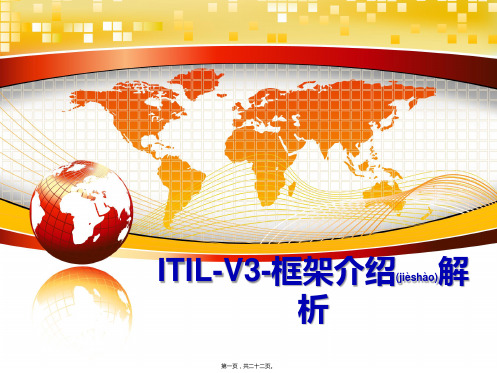
服务效用和保证效用保证客户资产的绩效服务资产收益率客户得到的针对目的如何提供的针对使用平均绩效绩效波动21世纪最宝贵的是人才服务或产品客户能力资源管理组织流程知识人员信息应用架构金融资本协调控制规划部署业务单元创造价值获得回报或抵扣成本潜在客户竞争对手调整人员供应商影响供应需求服务战略资源储备处第三方目录服务终止服务管道服务组合投资服务目录持续服务改进市场空间服务设计服务转换服务运营服务概念使用资源通过服务运营所获得的资产回报释放资源客户服务转换和服务运营服务知识管理系统展示层知识流程层信息整合层数据和信息服务知识库cmisamiskedb集成的cmdbcmdb1cmdb2dml1dml2服务管理日益提升的决策力数据信息知识智慧持续性服务改进目标识别?远景和战略?战术目标?运作目标1
• 中国摩托车工业发展启示
– 制定了简单的“最佳实践(shíjiàn)”结构和标准; – 供应商群体在车型设计和零件参数设定上可自由的
创新;
Seely Brown, John and John, Hagel Ⅲ 2005.
Innovation Blowback: Disruptive Management Practices from Asia. The Mckinsey Quarterly, No.1.
•而“服务”引导的ITIL3.0则是一座雄伟的“钢筋混 疑土大桥”
第四页,共二十二页。
议程
ITIL的发展(fāzhǎn)
ITIL v3
框架(kuànɡ jià)介
绍
ITIL v3生命周期
ITIL v3新知(xīn zhī)
翰纬与ITIL v3
第五页,共二十二页。
ITIL的“哲学(zhéxué)”
ITILv3-服务运营篇
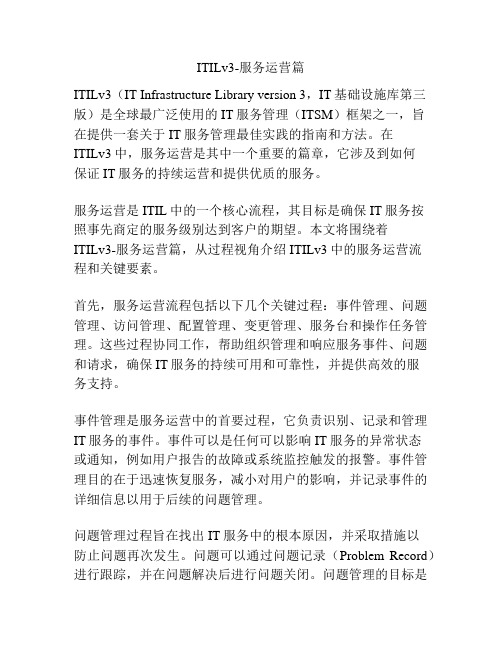
ITILv3-服务运营篇ITILv3(IT Infrastructure Library version 3,IT基础设施库第三版)是全球最广泛使用的IT服务管理(ITSM)框架之一,旨在提供一套关于IT服务管理最佳实践的指南和方法。
在ITILv3中,服务运营是其中一个重要的篇章,它涉及到如何保证IT服务的持续运营和提供优质的服务。
服务运营是ITIL中的一个核心流程,其目标是确保IT服务按照事先商定的服务级别达到客户的期望。
本文将围绕着ITILv3-服务运营篇,从过程视角介绍ITILv3中的服务运营流程和关键要素。
首先,服务运营流程包括以下几个关键过程:事件管理、问题管理、访问管理、配置管理、变更管理、服务台和操作任务管理。
这些过程协同工作,帮助组织管理和响应服务事件、问题和请求,确保IT服务的持续可用和可靠性,并提供高效的服务支持。
事件管理是服务运营中的首要过程,它负责识别、记录和管理IT服务的事件。
事件可以是任何可以影响IT服务的异常状态或通知,例如用户报告的故障或系统监控触发的报警。
事件管理目的在于迅速恢复服务,减小对用户的影响,并记录事件的详细信息以用于后续的问题管理。
问题管理过程旨在找出IT服务中的根本原因,并采取措施以防止问题再次发生。
问题可以通过问题记录(Problem Record)进行跟踪,并在问题解决后进行问题关闭。
问题管理的目标是减少IT服务的故障发生率,提高服务的可用性和质量。
访问管理是一个授权和身份验证的过程,确保只有经过授权的用户才能访问系统和数据。
它包含用户身份确认、授权、密码管理、访问控制和审计跟踪等步骤,以确保系统和数据的安全和合规性。
配置管理是指IT基础设施和组织相关配置项(Configuration Item,CI)的管理和控制过程。
配置项可能是硬件、软件、文档、用户和过程等等。
配置管理目的在于确保对配置项的准确记录和控制,以便及时找到和修复故障,保障服务的连续性。
ITILV3 名词解释中文版
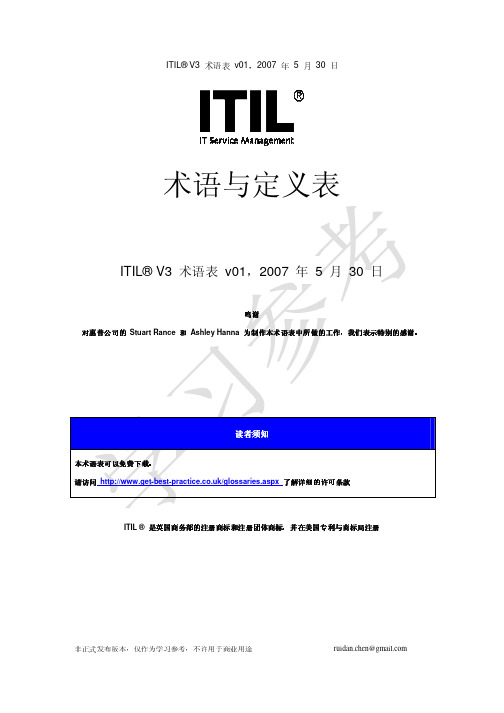
非正式发布版本,仅作为学习参考,不许用于商业用途
ruidan.chen@
术语表 , 年 月 日 ITIL® V3
标杆 (例如服,务标持杆续可改用进于):某事在特定时间点记录的状态。可以为配置、流程或任何其它数据集创建基准。 改•以前便• 持容进便管的续量在,理状确服管正改态定务理常进以当,。
非正式发布版本,仅作为学习参考,不许用于商业用途
ruidan.chen@
术语表 , 年 月 日 ITIL® V3
告警
定义
是。参表验见服明收务通IT验常服收先务标经、准过流评。程价、或计测划试或,其它它也交是付一物个完项整目、或准流确程、进可入靠下,一并阶满段足的指必定要的条需件求。 (。了访授服问权务用管运户理营才有)能时负访被责问称允或为许权修用限改户资管使产理用,或IT身从服份而务管有、理助数。于据保或护其资它产资的产保的密流性程、。完访整问性管和理可保用证性 (常用服于务处战理略与)外一部个客非户常的类关似系于。业务关系经理的角色,但要承担更多的商务责任。通 (。服务战略)核定提供 IT 服务的实际成本,并与预算对比,管理预算变化的流程 获。得正式授权,可执行某项角色任务。例如,认可的团体可以提供培训或进行审核 (参见服被务动运监营视)。利用自动定期检查,监视配置项或 IT 服务, 获得其当前的状态。 用在程于序达中到。特定结果的一系列动作。活动通常被定义为流程或计划的一部分,并记录 (服务设计)服务时间的同义词,通常用于对可用性的正式计算。参见停机时间。
预算
组参织见或“业预务算编部门制计”,划“在规指划定”时。间内收到和付出的所有资金的清单。
2024年ITILV3培训教程
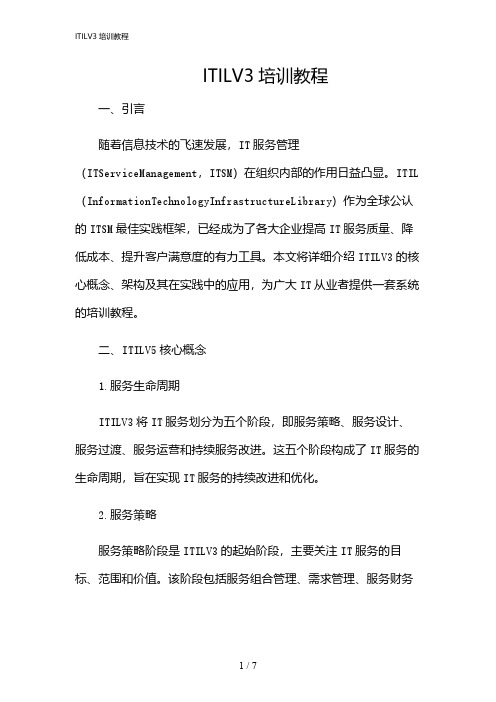
ITILV3培训教程一、引言随着信息技术的飞速发展,IT服务管理(ITServiceManagement,ITSM)在组织内部的作用日益凸显。
ITIL (InformationTechnologyInfrastructureLibrary)作为全球公认的ITSM最佳实践框架,已经成为了各大企业提高IT服务质量、降低成本、提升客户满意度的有力工具。
本文将详细介绍ITILV3的核心概念、架构及其在实践中的应用,为广大IT从业者提供一套系统的培训教程。
二、ITILV5核心概念1.服务生命周期ITILV3将IT服务划分为五个阶段,即服务策略、服务设计、服务过渡、服务运营和持续服务改进。
这五个阶段构成了IT服务的生命周期,旨在实现IT服务的持续改进和优化。
2.服务策略服务策略阶段是ITILV3的起始阶段,主要关注IT服务的目标、范围和价值。
该阶段包括服务组合管理、需求管理、服务财务管理等内容,以确保组织提供的服务能够满足客户需求,同时实现商业价值。
3.服务设计服务设计阶段关注如何将服务策略转化为具体的服务解决方案。
该阶段包括服务目录管理、服务级别管理、可用性管理、能力管理、信息安全管理、业务连续性管理等内容,以确保服务设计能够满足业务需求和法律法规要求。
4.服务过渡服务过渡阶段负责将服务设计阶段产生的服务解决方案顺利部署到生产环境中。
该阶段包括变更管理、发布与部署管理、服务资产与配置管理、服务验证与测试等内容,以确保服务过渡过程的风险可控。
5.服务运营服务运营阶段是ITILV3的核心阶段,负责提供日常的IT服务支持。
该阶段包括事件管理、请求履行、问题管理、访问管理、运营绩效评估等内容,以确保IT服务的高效运行。
6.持续服务改进持续服务改进阶段关注如何根据服务运营阶段的数据和反馈,不断优化IT服务。
该阶段包括服务测量、服务报告、服务改进计划等内容,以确保IT服务能够持续满足业务需求。
三、ITILV3实践应用1.组织架构与角色ITILV3定义了一系列组织架构和角色,包括服务提供者、服务消费者、服务台、服务经理等。
关于ITILV3的专业服务管理体系构建---ITSP的视角

如何从传统的以技术为主导的服务交付模式向以服务为 主导的专业服务团队转变以适应专业服务运营模式,传 统技术驱动的服务交付模式面临挑战。
如何在维持服务质量的同时以低成本实现大规模服务交 付,IT服务组织如何在人员、流程、工具、供应商体系 方面实现良性的变革,这是一个很大挑战,经验表明这 个过程至少需要2-3年。
从Managed Service到Designed Service
Designed Service
– 以服务生命周期为主线 – 按需设计、按需建设、按需服务 – 强调服务组织内各职能单元的集成
Managed Service
– 以流程为中心 – 专业化、标准化、规范化 – 在职能式架构上实行流程式管理(矩阵式)
现状和挑战
【定位】IT服务组织前期的业务主要以系统集成为主, 但随着客户自身建设的不断完善,IT服务组织需要适应 市场形势的变化,实现从系统集成商(侧重于技术研发 和实施)向专业的管理服务(Managed Service)提供商 转型。
【客户】IT服务组织的客户在变 – 从以前主要关注产品, 到更加关注服务,从而对IT服务组织的技术团队和管理 团队提出了越来越高的要求,IT服务组织需要整合资源 打通Call Center(前段,COPC) + 服务流程 (后端,ITIL)为 一体的服务链条。
人员
& 组织
•以个人为中心,强调“个人英雄 主义”;
•工具或技术驱动,关注活动 •临时性的资源和活动安排;
•偶尔的报告和评审;
•基于经验自发定义的流程角 色和职责;
•按职能进行技术分工,存在 “以人定岗”; •产品和服务驱动 •可获得资金和资源; •没有清晰的目的和目标;
ITILv3-服务运营篇
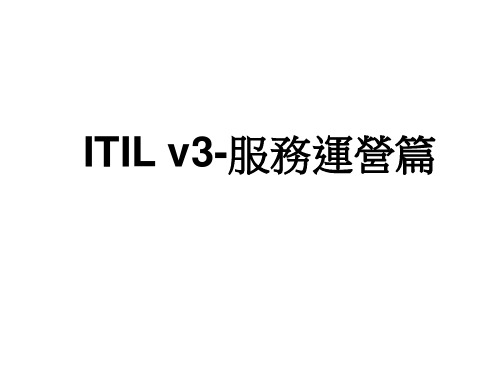
對於服務運營、平衡目標間的沖突是非常重要的:
1、內部IT與外部業務的觀點 2、穩定與響應 3、服務質量與服務成本 4、被動與積極主動的行動 服務運營人員需盡可能使兩者保持平衡,過分強調某一部分都會使 服務的質量降低。
Service Operation
User Access Management Know Error database Request fulfilment
Problem
Workaround
Known Error
Solution
RFC
問題管理指標
下列指標應該用來判斷問題管理有效性和效率: •一段期間問題總數量 •百分比的問題,解決的SLA目標(及百分比是沒有) •超出目標解決時間問題的數目。(用百分比表示) •未關閉問題數量和發展趨勢(靜態,減少或增加) •處理問題的平均成本 •問題的數目(打開和關閉和積壓) •有多少已知錯誤添加到已知錯誤資料庫(KEDB) •已知錯誤資料庫(KEDB)準確程度的百分比 •主要問題評價順利完成的百分比,並列出明細分類:處理時間,影響 的嚴重性,緊急度和優先級。
服務台結構:有多種選擇。常見的方式包括: 集中式服務台:作為所有用戶的單一聯繫點,可能還單獨設立了一個服務台來處理使用者在 業務應用系統方面的問題。 本地式:服務台分佈在多個地方。通常,將服務台劃分為多個本機服務台將會導致更加難以 管理。 虛擬式服務台:並沒有實質性的位置,這是由於使用了通信技術。2Leabharlann 23影響度1
1
緊急度1
2 2
二類 15 20 30 三類 30 40 60
用戶能承受的等待時間 現象\類別 系統崩潰 無法訪問 速度減慢 一類 10 15 20
“主動告知”
事故管理流程:
ITIL V3 的四大“魅”力
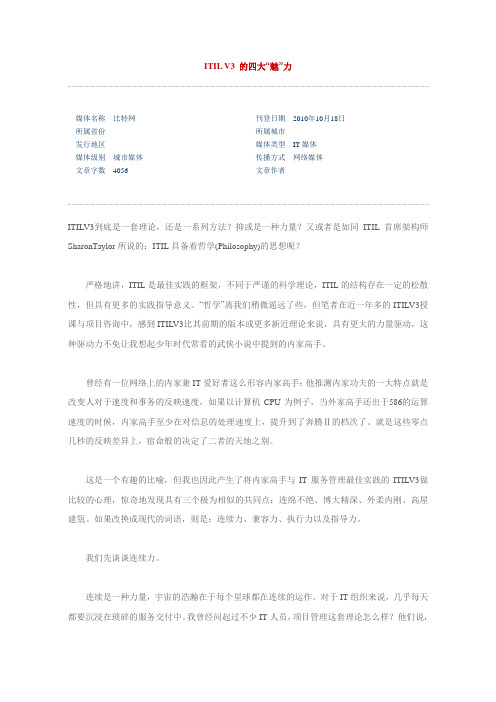
ITIL V3 的四大 魅”力 的四大“魅 力媒体名称 所属省份 发行地区 媒体级别 文章字数比特网刊登日期 所属城市 媒体类型2010年10月18日 IT 媒体 网络媒体城市媒体 4056传播方式 文章作者ITILV3到底是一套理论,还是一系列方法?抑或是一种力量?又或者是如同 ITIL 首席架构师 SharonTaylor 所说的:ITIL 具备着哲学(Philosophy)的思想呢?严格地讲,ITIL 是最佳实践的框架,不同于严谨的科学理论,ITIL 的结构存在一定的松散 性,但具有更多的实践指导意义。
“哲学”离我们稍微遥远了些,但笔者在近一年多的 ITILV3授 课与项目咨询中,感到 ITILV3比其前期的版本或更多新近理论来说,具有更大的力量驱动,这 种驱动力不免让我想起少年时代常看的武侠小说中提到的内家高手。
曾经有一位网络上的内家兼 IT 爱好者这么形容内家高手: 他推测内家功夫的一大特点就是 改变人对于速度和事务的反映速度,如果以计算机 CPU 为例子,当外家高手还出于586的运算 速度的时候,内家高手至少在对信息的处理速度上,提升到了奔腾Ⅱ的档次了。
就是这些零点 几秒的反映差异上,宿命般的决定了二者的天地之别。
这是一个有趣的比喻,但我也因此产生了将内家高手与 IT 服务管理最佳实践的 ITILV3做 比较的心理,惊奇地发现具有三个极为相似的共同点:连绵不绝、博大精深、外柔内刚、高屋 建瓴。
如果改换成现代的词语,则是:连续力、兼容力、执行力以及指导力。
我们先谈谈连续力。
连续是一种力量,宇宙的浩瀚在于每个星球都在连续的运作。
对于 IT 组织来说,几乎每天 都要沉浸在琐碎的服务交付中。
我曾经问起过不少 IT 人员, 项目管理这套理论怎么样?他们说,很好!不过现实中往往很难建立起独立的项目管理体系,要么琐碎小事不成项目,要么多个项目 交错迭代,所以等忙起来的时候,什么项目管理都丢脑后去了。
ITIL_V3培训教程
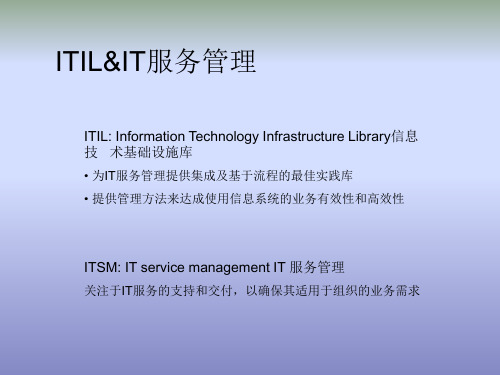
ITIL V3由英国政府OGC拥有。
ITIL V3核心书籍
SS
SD
ST
SO
CSI
服务的变更 客户关系管理
服 务 转 换
服务的运行
服务规划
服务开发
服务转换
服务改进
供应商关系管理
◎Crown copyright 2009 reproduced under license from OGC
ITIL V2 映射至V3
服务管理(service management)
•定义 服务管理是以服务的形式向客户提供价值的一组特定的组织能力。 •这种能力以管理服务的整个生命周期中所涵盖的各个职能和流程来 实现。 •服务管理也是由一系列知识、经验和技能体系所支持的专业实践。
服务价值(service value)
•效用和保证(Utility and Warranty)
关注于IT服务的支持和交付,以确保其适用于组织的业务需求
ITIL历史
1980年代末
• 英国政府项目启动 •大约80年代初由英国OGC开发(CCTA:中央计算机和电 信政府机构)出版第一本书
•从1985年开始,欧洲公司开始实施ITIL(基于 来自保险盒 金融公司)
1990年代初
•世界范围广泛接受的基于事实的IT服务管理标准 •将ITIL导入北美 •发布ITIL V1书籍
•一个集成的设计模型来转换战略目 标为服务组合和服务资产(portfoli os of services and service assets)
服务设计 – 内容
•服务设计从一组新的或变更的需求(a set of new or changed business re quirements)开始,以开发设计一个满足业务需求的解决方案结束。 •服务设计原则 •服务设计流程
- 1、下载文档前请自行甄别文档内容的完整性,平台不提供额外的编辑、内容补充、找答案等附加服务。
- 2、"仅部分预览"的文档,不可在线预览部分如存在完整性等问题,可反馈申请退款(可完整预览的文档不适用该条件!)。
- 3、如文档侵犯您的权益,请联系客服反馈,我们会尽快为您处理(人工客服工作时间:9:00-18:30)。
英国政府商务办公室(OGC)序
首席架构师序
前言…………………………………………………………………………………………
联系信息
致谢…………………………………………………………………………………………
首席架构师及作者
ITIL 创作组
指导者
更多贡献
ITIL 顾问团
评论者
第 1 章 介绍………………………………………………………………………………
a 7.1.11 软件测试管理
tm 7.1.12 安全管理
o 7.1.13 项目和整合(组合)管理
h 7.1.14 财务管理
7.1.15
@ 综述
业务情报/报告
a 实施持续性服务改进………………………………………………………………
e 实施持续性服务改进(CSI)需要考虑的关键(critical)事项
gs 我从哪里开始?
风险管理
a 风险管理之上的业务视角
tm 5.6.4 问题管理
o 5.6.5 变更,发布和部署管理
h 实施后评审
5.6.6 知识管理
@ 知识管理概念
a 5.7 综述
e 组织持续性服务改进…………………………………………………………………
gs 支持持续性服务改进(CSI)角色和职责
tin 6.1.1 持续性服务改进(CSI)活动和所需技能
m Tension 指标 il.co 目标和指标
使用组织指标 4.2 服务报告
a 4.2.1 报告政策和规则 tm 正确内容讲给正确听众
o 4.3 服务度量 h 4.3.1 目标
4.3.2 开发服务度量框架
@ 服务度量框架关键(Critical)基础 a 4.3.3 度量和报告不同级别
e 服务计分卡 gs 服务仪表盘(板) tin 4.3.4 定义度量什么
1.1 概述
1.2
1.3
1.4
@ 1.5 a 第 2 章
se 2.1 g 2.2 tin 2.3
背景 1.2.1 服务管理 1.2.2 出版领域的最佳实践 1.2.3 ITIL 和服务管理的最佳实践
1.2.3.1 服务策略 1.2.3.2 服务设计 1.2.3.3 服务转换 1.2.3.4 服务运营 1.2.3.5 持续性服务改进 意图 用法 本章概述 作为实践的服务管理……………………………………… 什么是服务管理? 什么是服务? 2.2.1 价值主张 贯穿生命周期的职能和流程
关键职责
6.1.4 服务负责人
关键职责
6.1.5 流程负责人
6.1.6 服务知识管理
6.1.7 报告分析
关键职责
关键技能和资质
6.2 权威矩阵
6.2.1 流程流动和 RACI
6.3 摘要
第 7 章 技术方面需要考虑的事项…………………………………………………………………
7.1 支持持续性服务改进工具
ITIL 版本 3-持续性服务改进
第 4 章 持续性服务改进流程…………………………………………………………………… 4.1 七步改进流程法 第 1 步-定义你将度量什么 第 2 步-定义你能度量什么 第 3 步-收集数据 第 4 步-处理数据 第 5 步-分析数据 第 6 步-呈现(Presenting)和使用信息 第 7 步-实施纠正行为 4.1.1 整合生命周期其他阶段与服务管理流程 监控和数据收集贯穿服务生命周期 监控和数据收集过程中其他流程角色 度量数据过程中其他流程角色 分析数据贯穿服务生命周期过程 呈现(Presenting)和使用信息贯穿服务生命周期 呈现(Presenting)和使用信息过程中其他流程角色 实施矫正行为过程中其他流程角色 4.1.2 指标和度量 多少关键成功因素和关键绩效指标?
关键概念 8.5 沟通战略和计划
8.5.1 定义沟通计划 沟通转变(transformation)
8.6 内容摘要 第 9 章 挑战,关键成功因素和风险…………………………………………………………
9.1 挑战 9.2 关键成功因素 9.3 风险 9.4 综述 编后记………………………………………………………………………………………… 附录 A:补充的指导……………………………………………………………… A1 创新,修订和改进 A2 支持持续性服务改进的最佳实践集
2.3.1 职能
2.3.2 流程
2.3.3 贯穿生命周期的专门化(specialization)和协作化(coordination)
2.4 持续性服务改进基本原理
2.4.1 持续性服务改进(CSI)意图
2.4.2 持续性服务改进(CSI)目标
2.4.3 持续性服务改进(CSI)范围
(CSI)
服务差距模型
7.1.1 IT 服务管理系列
7.1.2 系统和网络管理
7.1.3 事件管理
7.1.4 自动化事件/问题解决方案
7.2 第8章
8.1 8.2
7.1.5 知识管理
7.1.6 服务请求和实现(服务目录和工作流)
m 7.1.7 性能管理
il.co 7.1.8 应用和服务性能监控
7.1.9 状态分析工具
7.1.10 软件版本控制/软件配置管理
e 5.3.1 设定基准程序 gs 5.3.2 设定基准成本 tin 5.3.3 设定基准价值
5.3.4 收益 5.3.5 谁是棘手的? 5.3.6 什么是基准? 5.3.7 行业标准比较
流程成熟度比较 总体拥有成本 5.3.8 基准产生步骤 5.4 度量和报告的框架 5.4.1 平衡计分卡 平衡计分卡层叠 平衡计分卡和基于度量的管理
三、本免责声明以及其修改权、更新权及最终解释权均属作者所有。
文档说明: 翻译者:赵翔宇
联系方式:tingsea@ tingsea@
ITIL 版本 3-持续性服务改进
翻译:赵翔宇(tingsea@)
第 1 页 共 10 页
ITIL 版本 3-持续性服务改进
第 5 页 共 10 页
ITIL 版本 3-持续性服务改进
建立匹配战略的记分卡 建立报告 4.3.12 持续性服务改进(CSI)政策 4.4 持续性服务改进(CSI)投资回报率 4.4.1 建立投资回报率 4.4.2 设立业务案例 期望值-what’s in it for me? 数据匮乏环境业务案例 4.4.3 测量利益已达到 4.5 适合于持续性服务改进的业务问题 我们现在在哪? 我们想做什么? 我们需要什么? 我们能提供什么? 我们将得到什么? 我们已经得到了什么? 4.6 服务级别管理 4.6.1 服务级别管理目标 4.6.2 服务改进计划
ITIL 版本 3-持续性服务改进
ITIL 版本 3 持续性服务改进
免责声明: 一、本文档不对其中包含或引用的信息的准确性、可靠性或完整性提供任何明示或暗示
的保证。对于任何因直接或间接采用本文档提供的信息造成的损失,均不承担责任。如因使 用本文档出现法律责任,使用者应自行承担全部责任。
二、本文档标明文章的出处,并保留文章在原来媒体上的署名形式和版权声明,但本文 档对转载本文档的版权归属和权利瑕疵情况不承担核实责任。
8.4.1 建立危机意识
8.4.2 形成联合导向
8.4.3 建立愿景
8.4.4 沟通愿景
ITIL 版本 3-持续性服务改进
翻译:赵翔宇(tingsea@)
第 8 页 共 10 页
ITIL 版本 3-持续性服务改进
8.4.5 授权其他人来处理愿景 8.4.6 规划并建立短期盈利(wins) 8.4.7 巩固改进和产生更多变更 8.4.8 制度化变更 8.4.9 组织文化
ITIL 版本 3-持续性服务改进
翻译:赵翔宇(tingsea@)
第 6 页 共 10 页
ITIL 版本 3-持续性服务改进
5.4.1
SWOT 分析法
意图
如何使用
范围/延伸和平行
SWOT 分析通用缺陷
5.5
“戴明环”
5.5.1
使用“戴明环”来改进服务和服务管理流程
5.6
持续性服务改进(CSI)和其他服务管理流程
m 第 5 章 持续性服务改进方法和技术………………………………………………………………… il.co 5.1 方法和技术
5.1.1 努力和成本 5.1.2 实施评审和评估
a 5.2 估价 tm 什么时候估价 o 对什么估价以及如何估价 h 估价的优势和劣势
流程价值 vs.流程成熟度
@ 5.2.1 差距分析 a 5.3 设定基准
5.6.1
可用性管理
组件故障影响度分析
故障树分析
服务故障分析
技术观察
延伸的事故生命周期
5.6.2
能力管理
业务能力管理
服务能力管理
第6章 6.1
组件能力管理
工作量管理和需求管理
m 能力管理中的重复活动
il.co 5.6.3
IT 服务持续性管理
业务持续性管理,IT 服务持续性管理(ITSCM)和持续性服务改进(CSI)
3.9.4 收益
3.10
治理
3.10.1 企业治理
3.10.2 公司治理
3.10.3 IT 治理
3.11 框架,模型,标准和质量体系
3.11.1 框架
3.11.2 模型
3.11.3 标准
3.11.4 质量体系
ITIL 版本 3-持续性服务改进
翻译:赵翔宇(tingsea@)
第 4 页 共 10 页
持续性改进有益于度量
2.4.9 与其他服务生命周期阶段接口
服务策略
服务设计
服务转换
服务运营
第3章
m 3.1 il.co 3.2
3.3 3.4
a 3.5 tm 3.6 o 3.7 a@h 3.8 tingse 3.9
